Online advertising is expensive and competitive. So for charities and nonprofits — especially those with smaller budgets — it’s increasingly difficult to get a good return and justify your ad spend.
That’s where Google Ad Grants come in. These grants give nonprofits $10,000 a month to spend on Google’s ad platforms, so you can promote your organization to audiences who are searching for information about your cause. With an Ad Grant, you can attract donations, raise awareness, and recruit volunteers. Since its launch in 2003, Google Ad Grants have driven more than 14 billion clicks to nonprofit websites.
Google Ad Grants offer a great advertising opportunity for nonprofits. But with strict eligibility criteria and compliance rules, many organizations find it hard to qualify, maintain, and spend their grant effectively.
So how can you secure a Google Ad Grant in 2025 and maximize its value to your nonprofit? Here, learn all you need to know about how to make the most of your Google Ad Grant in 2025.
Who are Google Ad Grants for?
Google Ad Grants are exclusively available to charities and nonprofit organizations — but not all nonprofits are eligible. In addition, eligibility rules vary by country, so you’ll need to check whether your organization qualifies.
Organizations that aren’t eligible for Google Ad Grants include:
- Governmental entities or organizations
- Hospitals and healthcare organizations
- Schools, academic institutions, and universities
See a full list of country-specific eligibility guidelines here.
You also need to have the right resources to qualify for an Ad Grant. Google states:
“In order to qualify for Ad Grants, your organization must be an eligible nonprofit, have a high-quality website that meets our website policy, and be able to meet the program policies.”
If you’re considering applying, it’s worth reading through the Ad Grant policy compliance guide, as this sets out a number of limitations nonprofits need to be aware of. For example, you can’t host AdSense ads on your website or earn money from affiliate links. You must also adhere to specific advertising policies, such as maintaining a 5% click-through rate every month, and not bidding on single-word keywords.
How much can you get from Google Ad Grants?
Eligible nonprofits are given an ad budget of $10,000 USD (or £7,000 GBP) per month of in-kind advertising. There’s no minimum spend limit, but your funds won’t roll over if you don’t use them.
The limitations of Google Ad Grants
Google Ad Grants offer a massive opportunity for nonprofits to gain online exposure. But, unsurprisingly, Google isn’t just giving away free money. Several limitations apply, so let’s explore these and how they might impact you.
1. Ad Grants don't compete with normal paid ads
While its Ad Grant program is generous, Google ultimately wants to make a profit. So it doesn’t make commercial sense for them to list Ad Grant ads above profitable paid search ads. As a result, Ad Grant ads will always appear below paid search ads.
That means you need to be very tactical when selecting keywords and assigning bid values. Bidding on highly competitive keywords is unlikely to land you on the first SERP, and could quickly drain your ad budget.
Here’s an example: a search for “animal charity” serves ads from well-known charities that receive millions of dollars in donations each year.
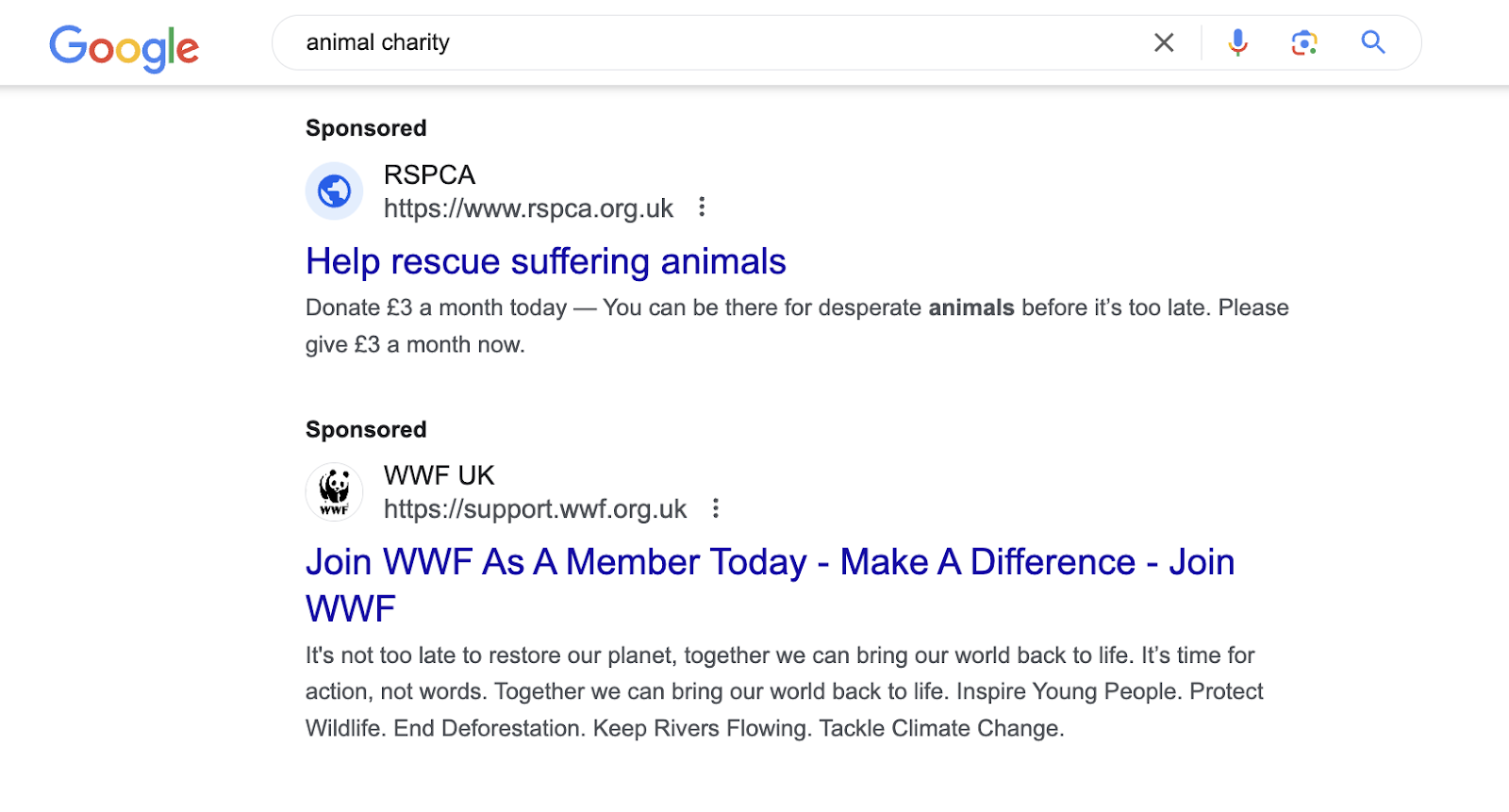
But bidding on more refined, relevant keywords increases your chances of ranking in higher positions despite having a lower budget:
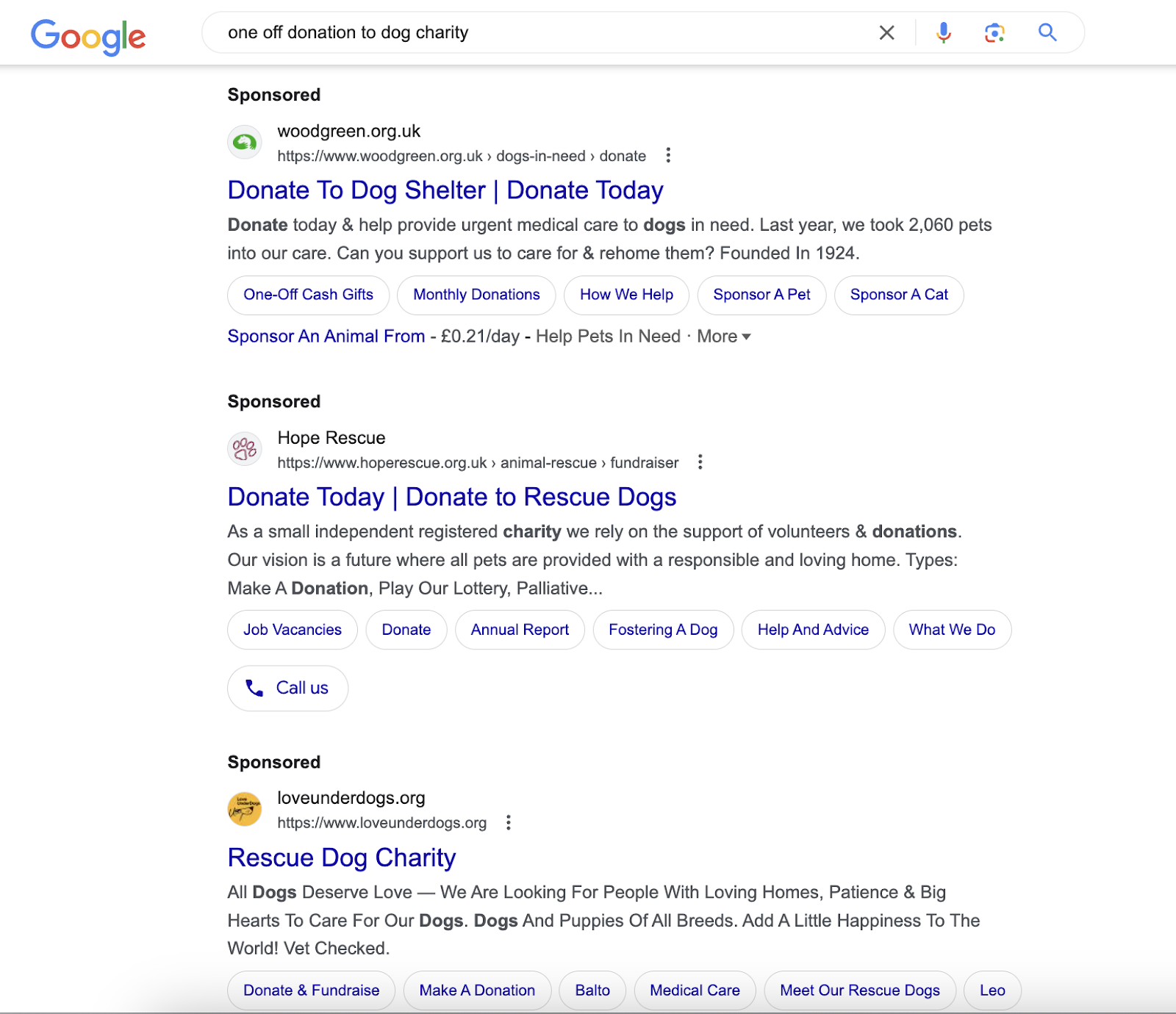
This isn’t a simple skill. Many nonprofits have found they need to invest in pay-per-click marketing expertise to get the most out of their Google Ad Grant.
2. You can only spend it on certain ad types
Until September 2024, Google Ad Grants could only be used to advertise via in-search text ads. These ads only show on the search engine results page (SERP); other avenues (such as Display Network and YouTube) are off-limits.
Google has since announced that Ad Grants can be used on Performance Max. However, there are pros and cons of Performance Max, as well as certain limitations that will create more challenges for Ad Grant advertisers. We’ll go into these in more detail below.
3. You can't retarget previous site visitors
Retargeting is a valuable tool for all advertisers, as it keeps your organization top of mind for previous site visitors. It’s a relatively cheap way to get more donations, event sign-ups, or volunteer enquiries.
Unfortunately, you can’t use your Ad Grant to retarget previous site visitors. Even the introduction of Performance Max won’t help here, as retargeting opportunities within PMax have limited accessibility and visibility.
4. You can't spend more than $329 per day
$10,000 is a sizable monthly ad budget, especially for smaller nonprofits. But unfortunately you’re not permitted to spend this however you like over the course of the month. The budget is split into an allowance of $329 per day; if you don’t spend this, it won’t roll over to the next day.
5. You must use conversion-based bid strategies (or accept a $2 bid limit)
Google Ad Grant bids are currently limited to no more than $2 for click-based objectives. This is rarely enough to get much visibility, especially for competitive or valuable keywords.
You can get round this by using automated bid strategies, such as Maximize Conversions, Target CPA (cost per action), or Target ROAS (return on ad spend). For these, Google bids on your behalf, overriding the manual limit. But these strategies come with their own risks, especially if Google is unable to accurately predict high-converting ads.
6. You can't bid on certain keywords
Google restricts which keyword types you can bid on with an Ad Grant:
- No single-word keywords (except for branded keywords).
- No generic keywords (for example, “donate” or “charity”).
- Keywords must have a Quality Score of at least 3.
Following these guidelines is likely to give you better results. But if you’re just getting started with Google Ads, adhering to all these requirements can feel overwhelming.
How to apply for Google Ad Grants
Here’s how to apply for a Google Ad Grant:
- Apply for a Google for Nonprofits account. Use a Google account that’s linked to your organization and answer the eligibility questions. It can take a couple of weeks for Google to review and approve your application.
- Activate your Google Ad Grant. Sign in to your Google for Nonprofits account, then click “Activate Products”. Under Google Ad Grants, click “Get Started” then complete the form and click “Activate”. Wait for an email confirming Google has reviewed and approved your Ad Grant activation (this can take a few business days). Learn more in the Google Ads activation guide.
- Accept the billing profile. Google won’t charge you for using Google Ad Grants, but you will need to accept the billing profile sent to you via email.
- Launch your first campaign. With your Ad Grant application approved, you can now start advertising. The video below shows you how to set up your first Ad Grant campaign:
Google Ad Grant best practices
A thriving Google Ad Grant account won’t just give your organization great exposure; it also helps you retain your funding. Here are nine best practice tips for Google Ad Grant users.
- Set a specific goal — Align all your Ad Grant activity with a specific, measurable objective that results in conversions. Whether you want to attract donations, event attendees, or volunteers, setting a goal upfront will help you structure campaigns and write ads effectively.
- Don’t set and forget — Like all PPC campaigns, Google Ad Grants need regular check-ins and refinements to maintain their success. This is really important for achieving that 5% click-through rate month-on-month.
- Set up conversion tracking — Conversion tracking is the best way to ensure you’re getting results. Follow these conversion tracking best practices to optimize campaign monitoring. (Pro tip: set up an MCC manager account to monitor Ad Grant and paid ad conversions side-by-side).
- Structure campaigns effectively — Use systematic campaign structuring to allocate your budget effectively. Keep ad groups highly relevant and specific to each target keyword.
- Choose keywords tactically — Take note of the keyword targeting limitations for Ad Grant users, and use Google Keyword Planner to select keywords strategically.
- Don’t copy a paid ad strategy — Because you have fewer options when it comes to bidding, keyword selection, and ad targeting, standard paid ad strategies may not be as effective for Ad Grant campaigns. Plus, pay extra attention to ad quality factors like Ad Rank and Quality Score, as these can massively impact ad visibility and spend.
- Invest in PPC expertise — If you don’t have an in-house PPC specialist, it may be worth outsourcing your Google Ad Grant account management to an expert. This is especially true if you’re planning to use Performance Max campaigns, where you’ll have less control over your ad spend.
- Run brand campaigns — Gain brand awareness (and boost your average click-through rate) with campaigns that target your brand name. Follow these dos and don’ts of bidding on branded keywords for optimal results.
- Use Performance Max for simpler advertising — Performance Max is designed to simplify the Google Ads experience, making it more accessible for inexperienced nonprofit advertisers. That said, it does have some challenges, which we’ll explore in more detail below.
See more Google Ad Grant hacks in this video from Reach Right:
Can you use Performance Max with Google Ad Grants?
Yes — Google has started rolling out Performance Max to Ad Grant advertisers. (Note: as of October 2024, PMax for Ad Grants is still in beta, but will be rolled out to all advertisers soon.)
But there are limits on how Ad Grant users can employ Performance Max compared with regular advertisers. At present, PMax for Ad Grants seems to be a slightly enhanced version of dynamic search ads, so users don’t need to target individual keywords. Instead, Google’s algorithm uses your landing page and ad assets to create and serve targeted ads based on user searches.
This table shows the differences between standard PMax users and Ad Grant PMax users:
| PMax inventory access | Standard PMax campaigns | Ad Grant PMax campaigns |
| Dynamic search ads | ✅ | ✅ |
| Discovery | ✅ | ⏳ |
| Gmail | ✅ | ⏳ |
| Maps | ✅ | ⏳ |
| Display Network (GDN) | ✅ | ❌ |
| YouTube | ✅ | ❌ |
| Shopping | ✅ | ❌ |
In future, Google may roll out additional PMax features to Ad Grant users. Google Discovery, Gmail, and Maps have been highlighted as potential areas of expansion, though there are no reports of Display Network or YouTube advertising being included any time soon.
You can access these valuable platforms, but this won’t be funded by your Ad Grant. You’ll need to allocate your own PPC budget and set up a standard Google Ads account to access YouTube and GDN.
The main benefit of using Performance Max instead of a standard search campaign for Ad Grant users is that it’s a simpler, more user-friendly platform for less experienced advertisers. But there is a tradeoff: you’ll also have less campaign control, fewer metrics, and limited visibility of your results.
What marketers are saying
Making PMax available to nonprofits is a massive shake-up of Google Ad Grants. But with limited features and benefits, it’s also somewhat controversial. Senior paid media consultant Yoann Ferrand offered this positive expert perspective:
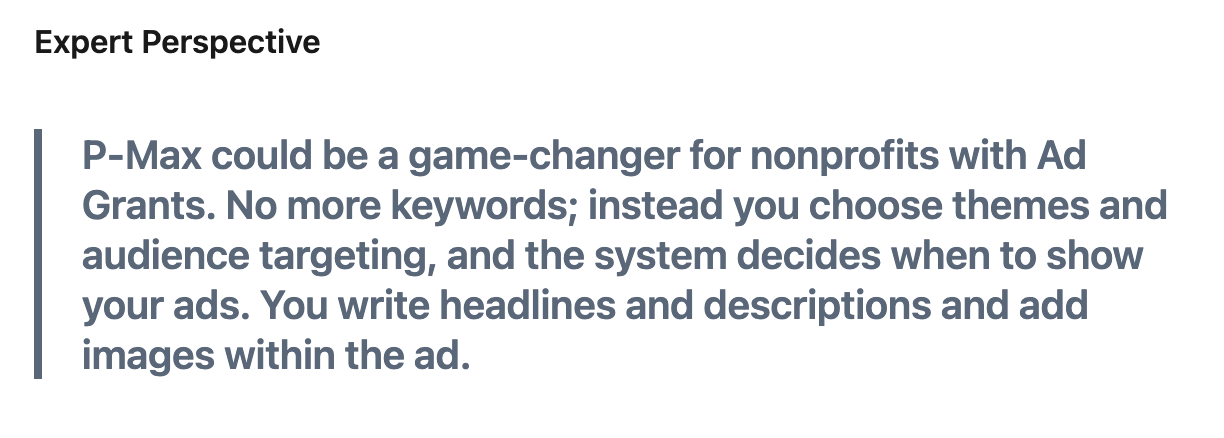
But the response from many other marketers has been less favorable, with some highlighting the limited features of PMax for Ad Grant users and the flawed perception that PMax is easy to manage:
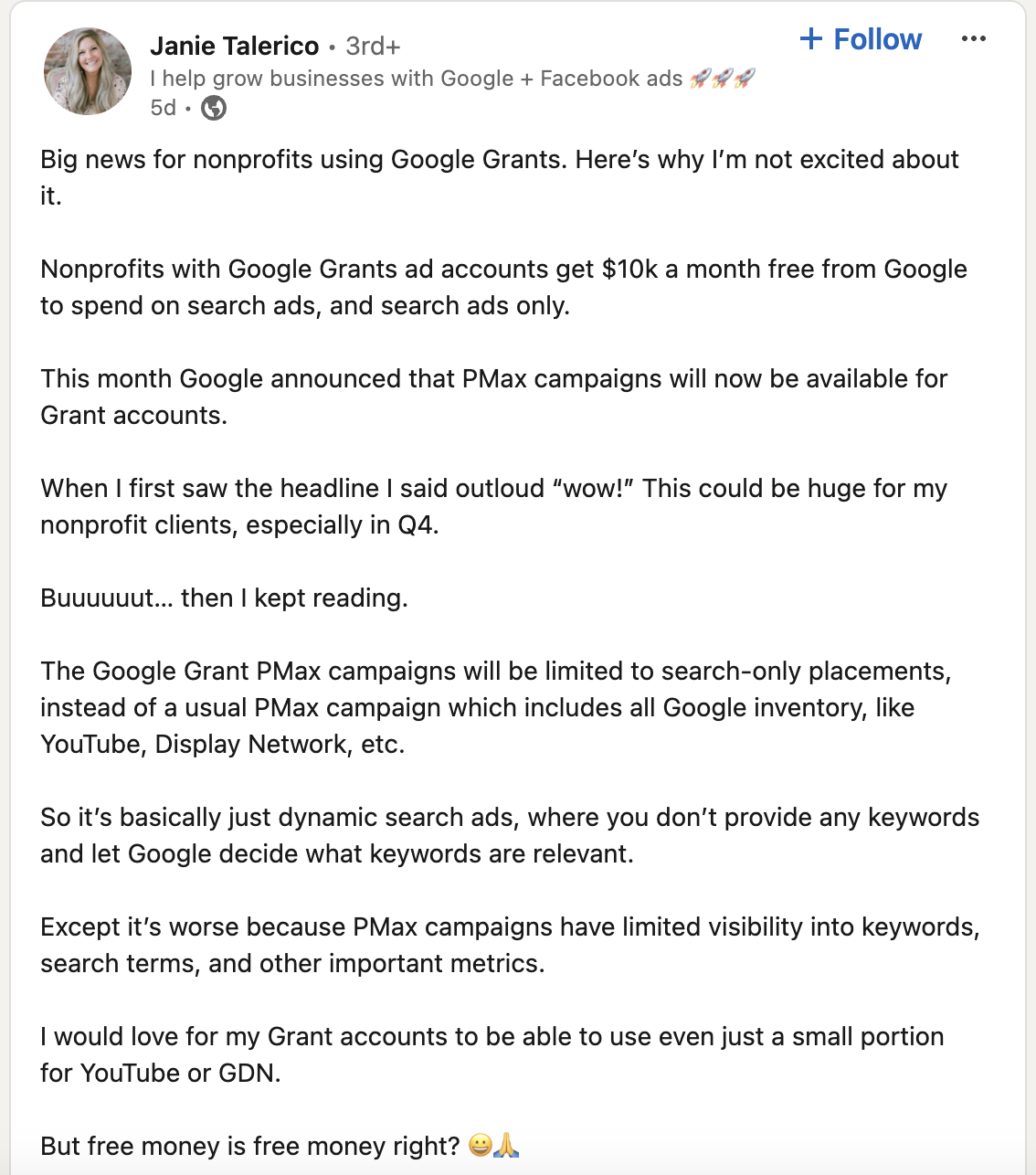

In addition to the limited features of PMax for Ad Grant users, marketers are also aware of Google’s motives in offering this substantial grant, as well as the limited support for Ad Grant users compared with paying advertisers:
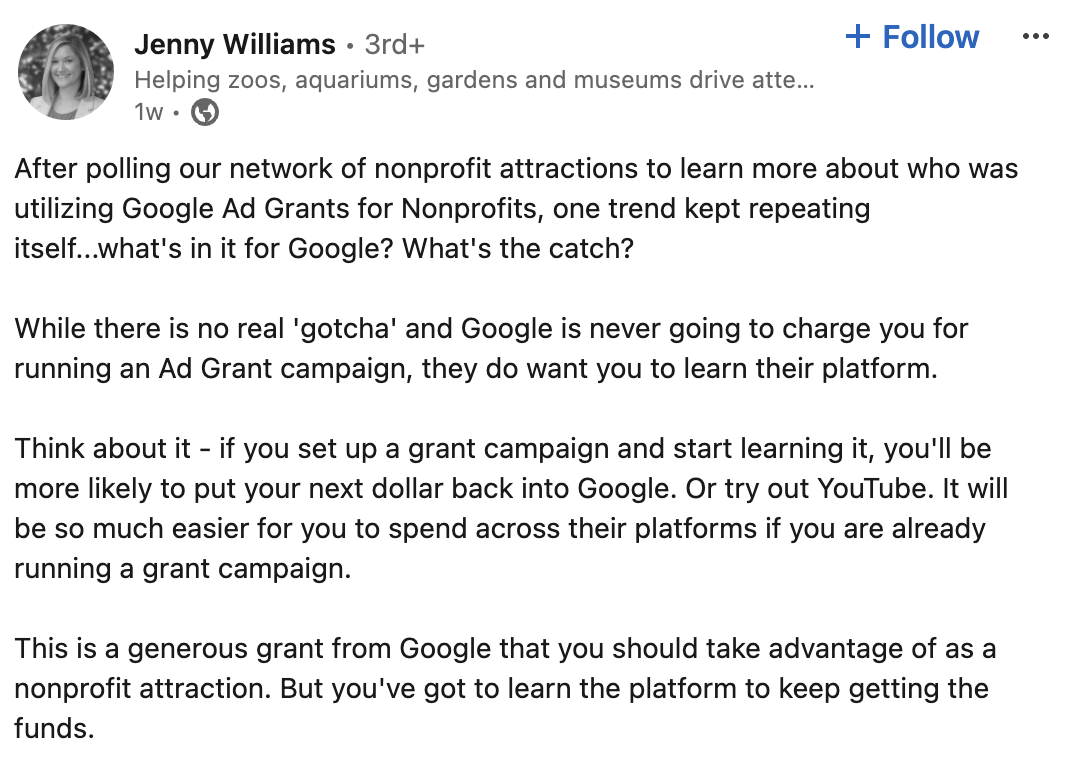
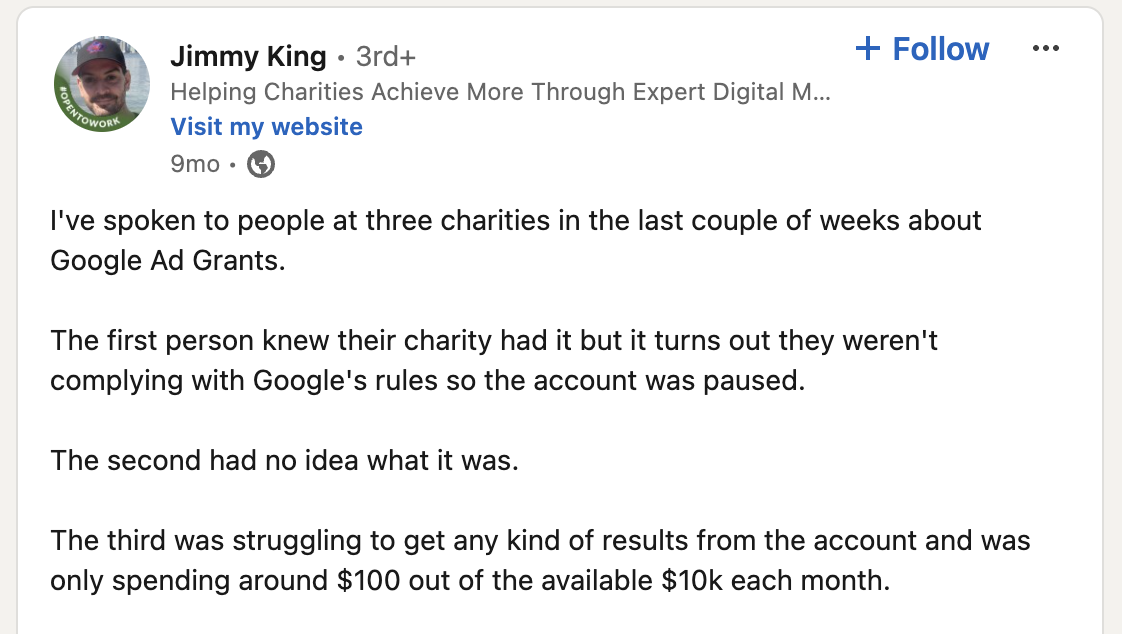
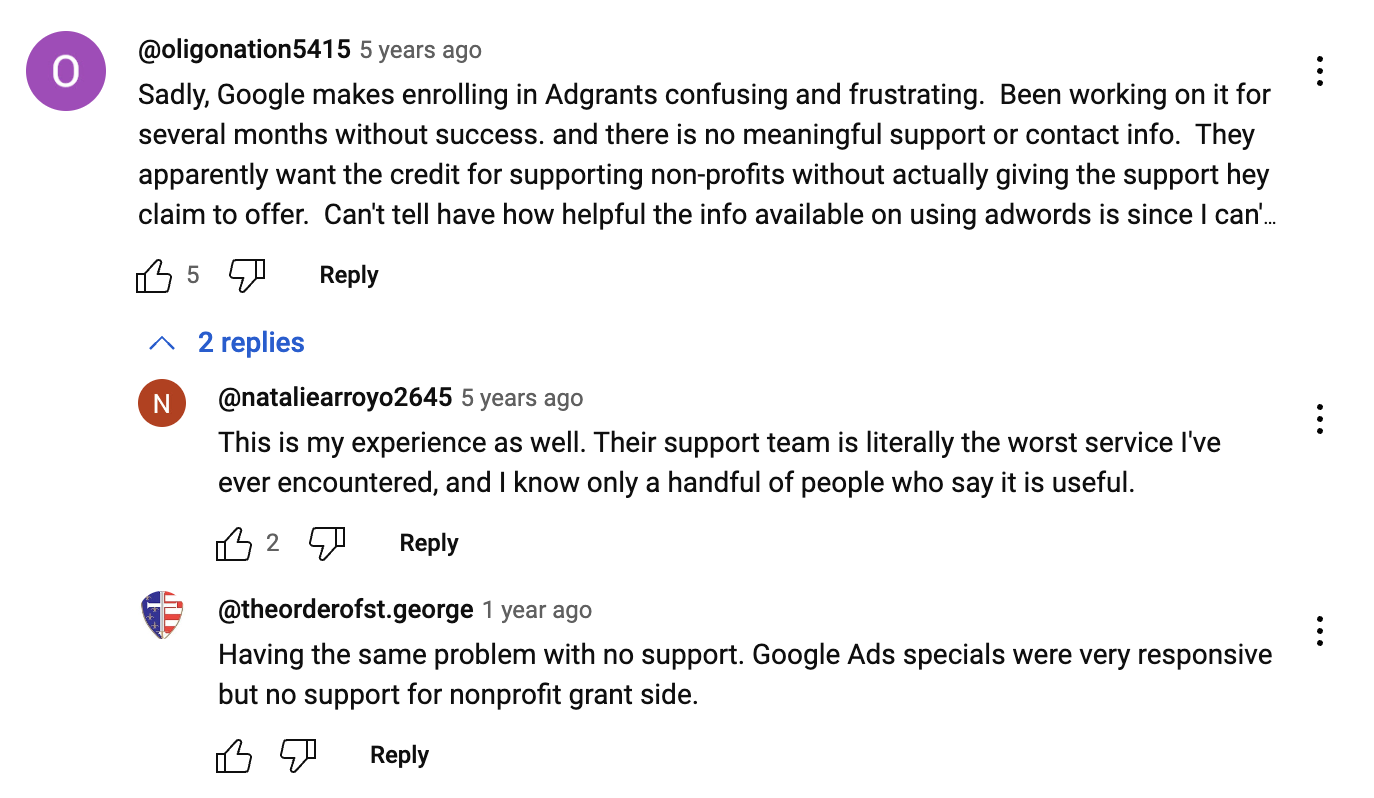
Ultimately, while the ad spend is generous, Google Ad Grants are unlikely to make your charity a quick buck. On the contrary, you need to put serious effort and resources into staying compliant, utilizing best practices, and understanding the limitations to make the most of this opportunity.
Using PMax to get the most out of your Google Ad Grant
Despite its limitations, Performance Max can be a really beneficial platform for nonprofits. Here are ten ways to use PMax to get the most from your Google Ad Grant.
1. Keep your goal(s) front of mind
As long as your campaign aligns with your objectives, you won’t go far wrong. Set a goal before creating any campaigns, and use this to build, target, and optimize your campaigns for the best possible performance.
2. Include clean, reliable data
Performance Max works best when it has lots of clean, useful campaign performance data. Google uses this to create and serve high-performing ads to your target audience, maximizing conversions and helping you reach your goals.
Keeping data as clean as possible is essential when using PMax. That’s why it’s a good idea to invest in a solution that minimizes bot traffic that may be skewing your results. Find out how to identify and remove suspicious and invalid traffic from your PMax campaigns with Lunio for Performance Max.
3. Refine audience signals
Without keyword targeting, it’s hard to know where your PMax ads are going to appear. Instead, you can use audience signals to tell Google who and where your ideal audience is likely to be.
Google can override your audience signals. But by indicating your intended audience, you can help Google put your ads in front of the right people. Learn more about using audience signals effectively in this video from Paid Media Pros:
4. Test PMax campaign variables
While PMax includes automated campaign testing, there are some things you can test manually. This includes:
- Different campaign and/or asset group structures
- Final URL expansion
- Audience signals
Regular testing helps you continually optimize your campaign to maximize conversions.
5. Don’t target branded keywords in PMax campaigns
Branded keywords typically have much higher conversion rates than non-branded keywords. So to give Google a more accurate picture of your PMax campaign success, exclude branded keywords from PMax campaigns.
Instead, target branded keywords with a standard search campaign. You can still use your Google Ad Grant, and you won’t feed PMax artificially high conversion-rate data.
Pro-tip: Use the search terms report within PMax to see if your ads are showing for branded keywords. If so, refine your negative keywords to remove these.
6. Stay up-to-date with PMax opportunities
It’s still early days for Ad Grant PMax users, and there’s a lot of talk about developments in this area. If new ad placements (such as Gmail and Discover) become available, you’ll need to update your ad assets to increase their chances of converting.
In future, you may need to add images, regular videos, and vertical videos to your PMax campaigns. So be ready to go with persuasive messaging and quality assets.
Check out what’s new for Performance Max in 2024 to see the newest features and updates.
7. Write compelling, accurate ad copy
Headlines, descriptions, landing page copy — these are all essential for maximizing conversions. Inaccurate or irrelevant creative won’t convert, and may lead Google to display your ads to the wrong audience. So make sure your messaging is consistent and compelling from the start.
Learn how to write ad copy that sells to drive more PMax conversions.
8. Add negative keywords to PMax campaigns
While you can’t actively target keywords in PMax, you can tell Google which keywords you don’t want to show up for. This is a great way to improve targeting and ensure your ads aren’t showing up in inappropriate or unhelpful placements.
If you’re still appearing in the wrong places despite optimizing your negative keywords, consider submitting a Performance Max campaign modification request form.
9. Find the right support
Even if you’ve used Google PPC platforms before, switching to PMax is a big learning curve. Many of the metrics you take for granted in standard search campaigns are no longer available, and you can’t target or test ads in the same way.
If you’re unsure how to use PMax campaigns effectively, it’s a good idea to get some support. Whether this involves outsourcing to a PMax expert or upskilling your current PPC staff, investing a little of your marketing budget in this skillset can help you get more from your Google Ad Grant.
10. Give PMax time to learn
Be patient when it comes to tweaking your campaigns. PMax needs time to learn about your organization, goals, and messaging. So avoid the temptation to make any changes within the first 30 days of launching your campaign (you can set up alerts scripts in PMax to notify you if something is seriously wrong).
On a related note, don’t make too many changes at once. Changing too many variables at once makes it hard to know which changes are impacting your results.
Google Ad Grant FAQs
1. Can Ad Grants be used for international campaigns?
Yes. Regardless of where your nonprofit is registered, you can target users around the world. You just need to make sure your targeting adheres to the Ad Grant policies.
2. Can I set up Shopping campaigns with Google Ad Grants?
No, you can’t use your Ad Grant to create a Shopping campaign. You can, however, sell products and merchandise via search or PMax campaigns, as long as commercial activity isn’t the sole purpose of your website.
3. Can I track donations received from my Google Ad Grant campaign?
Yes. Certain donation platforms integrate with Google Ads, making it really easy to track donations. If your platform doesn’t offer direct integration, you can use Google Tag Manager to track donation clicks.
4. Can I run paid ads alongside Google Ad Grant campaigns?
Yes. In fact, you’ll need to run paid ads if you want to take advantage of Google’s full advertising suite, such as YouTube Ads and retargeting campaigns.
You don’t need to worry about your ads competing with one another, because paid ads always appear above Ad Grants.
Get even more from Google Ad Grants with Lunio
Google Ad Grants allow nonprofits and charities to attract donations and build brand awareness for free. And with PMax now available, more organizations can take advantage of this considerable grant.
But there are some catches. For example, there are significant limitations to how and where you can spend your Ad Grant. Plus, Ad Grants will always play second fiddle to paid ads, so many nonprofits end up paying for ads to gain a competitive edge. And when you’re paying for ads, it’s more important than ever to avoid wasting your budget on fake clicks and invalid traffic.
Lunio protects paid ads and PMax campaigns from invalid traffic, ensuring only real users click on your ads. Find out how invalid traffic affects your website with a free, no-obligation 14-day free trial and discover how to optimize your ad spend with Lunio.



%20Blog%20Header-2.png?width=300&name=670e4e2fa97b88ac5e212693_How%20to%20secure%20google%20ad%20grants%20(+make%20the%20most%20of%20them)%20Blog%20Header-2.png)